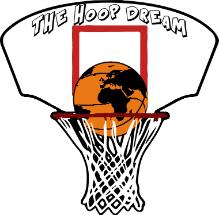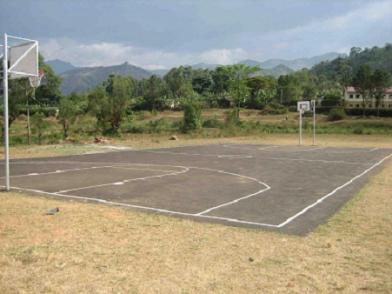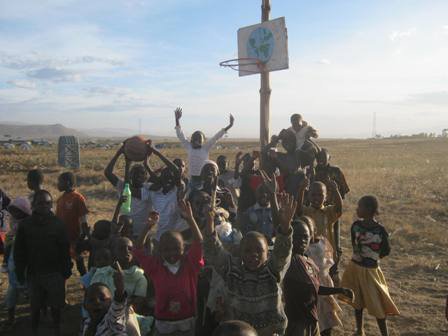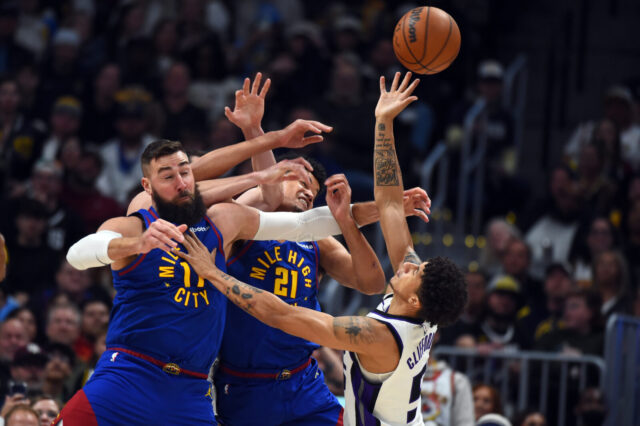This is the story behind The Hoop Dream. Brian Joseph Smith is the president and founder of The Hoop Dream and he partnered with Americas Association for the Care of Children (AACC) which is a registered 501c3 non-profit, based out of Boulder, CO. Their mission is to bring the game of basketball to East Africa where Brian and his team currently have 13 hoops throughout Kenya and Uganda.
The Hoop Dream.org webpage is available by clicking this link.
Donations can me made on the website under the section titled “Get Involved” using Paypal.
Be sure to “Like” The Hoop Dream on Facebook to hear about all upcoming events.
To understand why The Hoop Dream is important we must learn about Brian Smith, his journey to Africa, and the goals he has in place for his non-profit. It is this writer's belief that once you hear Brian's story, you will want to get involved with The Hoop Dream.
***
"You move to Portland for two years – that's not on your own. You're still calling your mom every day if your car breaks down or if you're broke. You can't do that over there. I wanted to totally get myself away from anything I knew; not be able to go to McDonalds and stuff like that. And do something, even in my mind, that was crazy – just because you can." -Brian Smith
Brian Smith's journey officially began in May of 2010, but his dream of taking the game of basketball to Africa was born years before that.
"He started thinking about this before he went into high school," said Susan Watts, Brian's Mother. "He was going to go to Africa and he was going to teach kids how to play basketball. It was a dream for him. Once he got into high school he didn't talk about it too much. I thought it was something that was going to fade. When he graduated from college he said to me on his graduation day, ‘Mom, I'm going to Africa.' By May of that year he was gone."
Gone, at the age of 22 and headed to Cape Town, South Africa to work for a basketball non-profit. He took care of all the little things to make his trip possible, like going through the process to acquire a three-year visa in South Africa where Brian believed he would spend his entire stay. He got all the required vaccines. And he saved up enough money to hopefully last for – an open ended stay.
"After I graduated I was working as a bellman and saved up about $25,000," said Smith. "I bought a one way [plane] ticket. I'm going to ride this out and see where it takes me."
The popular graduation gift of Dr. Seuss' "Oh, the Places You'll Go!" truly comes into play here. Brian would travel to various countries and villages. But before we get into that – it's important to get to know more about the man himself.
Brian Joseph Smith
"How many of us ever live our true dream and passion? Not very many, which is something that he is doing. This is his passion in life, it is his dream. " -Susan Watts
Brian is a Colorado native and grew up in Littleton. As I sat down to get to know him we discussed LaPhonso Ellis, Antonio McDyess, and Kenneth Faried. He’s a Nuggets fan through-and-through. He attended Dakota Ridge High School and grew up playing the game that Dr. James Naismith invented in 1891.
"Basketball kept me out of a lot of trouble," said Smith. "If I didn't keep my grades at a B average, my Mom would take me off the team."
But kids will still be kids and maintaining grades as a youngster can be difficult.
"I remember being taken off a team mid-season [in elementary school] because I fiddled around in art class. I was off the team the next day," said Brian. "I don't think I'll ever forget that hurt, leaving my team out there and not being able to play. It was a privilege to play."
His play on the court in high school would earn him scholarship offers from some Division-II schools, but Brian dreamed of bigger things for himself as a basketball player.
"My goal was to always play Division-I," said Smith. "I had scholarship offers to go play DII ball, but I went to Otero [Junior College in La Junta, CO]."
Brian hoped that he could prove himself at Otero and play his way to a Division-I program. He red-shirted his freshman season at the junior college (meaning he would sit out a year and then be considered a freshman in his second season). He played in just a handful of games in his redshirt-freshman season, while recovering from a broken hand (an injury suffered on the court), and then he re-broke that same hand later in the season – ending his year and his career.
He came back to the Denver area and graduated from the University of Colorado Denver. Brian was eager to begin his life after college.
"It was time to shift my dream," Brian said. "In retrospect it worked out exactly the way I would have wanted it to."
Why Africa?
"I've been here all my life. I'm a Colorado native and I've never lived anywhere else. I was determined to do something on my own." -Brian Smith
One of Brian’s full-courts in Budadiri, Uganda.
Growing up, Brian's family went on vacation to Mexico and Honduras. He used those trips to pique his interest in travel and would hold on to those memories.
"It gave me a taste for wanting to be outside the country and knowing that there was a whole different world outside of Denver." said Smith.
What Brian was really determined to do was to push his limits, get himself out of his comfort zone, and share his knowledge of the game in a way that comes natural to him.
"He can talk to anybody about anything," said Susan Watts. "When he was younger we'd take the light-rail down [to Nuggets and Rockies games] and he would get into conversations, every time with adults. He just has a way with people."
Brian credits his grandfather, Dave Watts, 79 years-old, for really getting him interested in travel, helping others, and Africa. Dave Watts is a remarkable man. He founded and built the San Marino Retirement Community in Westminster, CO and uses profits from that community to fund other humanitarian projects.
Dave has helped sustain Momma Beth's feeding center in Kijabe, Kenya, built an orphanage in Nicaragua with another one on the way on the Atlantic coast of Nicaragua, and is currently helping to fund a hospital in Northern Haiti. It is at Momma Beth's feeding center where Brian's story takes off.
"Grandpa Dave actually found the first place where I built a hoop," said Brian. "He was on safari in Kenya, wanted to do some exploring, and [Grandpa] asked the conductor to take him to [visit] her village. Turns out the safari guide's mother was feeding like 90 kids a day [at the village]."
The mother's name was Momma Beth. When asked how she was providing food for this many kids, according to Brian she responded by saying sometimes somebody would give her some potatoes, but "the Lord provides."
"You could see [Momma Beth] was really sincere and we started sending money every month to help feed these children." said Dave Watts.
The kids were on a corn-based diet. Dave offered to start sending money to help give the kids a balanced diet. They now feed roughly 250 kids a day.
"That's how I got my first contact in Kenya," said Brian. "I knew [Dave] would have my back a little bit. Having seen what he had done in numerous places; my parents were probably more accepting of me going to help."
The Story Before The Hoop Dream Could Be Born
"He started out in Cape Town, South Africa and the communication there was okay, but then he would travel into these smaller villages and there were times I wouldn't hear from him in days-and-days. I'd ask myself, if something happened to him, where would I even start to look? It was a very stressful part of my life, but it was his dream. So, what am I supposed to say? No, you can't go! I wasn't about to do that either." -Susan Watts
Before Brian arrived in Cape Town, he secured a job with a basketball non-profit, but didn't know what to expect. Brian wanted to roll up his sleeves and get to work with the children, but the non-profit had other ideas for him.
"When they see a white kid with an education, they want you in the office helping with the logistics of the non-profit, they want you talking to people and soliciting, and doing computer work behind a desk. I didn't have an interest in that. I wanted to coach; I wanted to spread my passion of the game [of basketball] to the kids."
Finally he was given the opportunity, through the non-profit to work directly with the kids. However, transportation got in his way. The car he was given to drive to the schools constantly broke down and the public transportation was too slow for Brian to make it to the schools to work with the children.
"I'd have to call these principals every day and tell them I can't come to [coach] the practices." said Brian.
It was a huge disappointment to him not to be able to make it to the schools, and he felt like he was letting the youngsters down. Opportunity comes in a lot of forms. The disappointment Brian felt lead him into a new direction, a path where he would venture out into East Africa on his own.
"I said to myself, I bet there are a lot of places that don't have basketball courts." said Smith.
The Hoop Dream is Born
"I can't tell you how many basketball hoops he and I took down. We would just put a ladder on top of my car and go take down hoops." -Susan Watts
Brian came back to Littleton for Christmas in 2010, but it was not just to spend time with family and friends. He was on a mission to collect basketball rims to take back to Africa. He collected roughly 20 rims in the Littleton area for his return to Africa and went about it in an interesting way.
"The most elementary way you can think of," said Smith. "Just going around my neighborhood and looking at somebody's house to see if they have a hoop, putting a flyer on their door, and hoping they'd call me."
He found that plenty of "empty nesters" were eager to donate their hoops; provided Brian came and took them down. When it was time to return to Africa, Brian packed up the rims in two big boxes and was ready to go build some courts. His dream was close to becoming a reality.
Trials and Tribulations in Kenya
"The first time I got malaria was awful." -Brian Smith
Brian did not get any malaria prevention medication when he left South Africa for East Africa. He didn't need it in Cape Town, as malaria is not common, but it would have come in handy in Kenya and Uganda. Malaria is a disease that dates back at least 4,000 years and symptoms include fever, chills, diarrhea, and vomiting.
"The first time [Brian got malaria] this guy took him into his house, gave him his bed, and took care of him," said Susan. "The people in Africa are amazing."
Brian was suffering from flulike symptoms and attributed not feeling well to just having the common cold. After experiencing worsening conditions after 10 days, Brian decided it was time to get checked out and the doctor told him that he had indeed contracted malaria.
"I got the medication, and three days later I was fine," said Brian. "So when I caught it the second and third times, when I started to get the feeling that my body wasn't right, I'd go get the test and the medicine and sure enough it was gone," said Smith.
There is an easy cure to malaria and it is inexpensive. Brian's medication cost him $10, but that is a lot of money to a lot of families in Africa. It's hard to understand why this medication cannot be provided for Africans in need and that's one realization that Brian often struggled with.
Getting sick is a big worry for people when traveling to a different continent, but there are other fears people have, too. Brian has faith in humanity and fear does not bother him when traveling alone in a foreign country.
"You definitely have nervous situations once you get there. Like somebody comes up to you at the bus depot and tells you they have a gun in their pocket. Well then you're obviously going to get nervous," said Brian. "But before I went I knew stuff like that was possible and to me it was worth risking."
Fear can prevent people from going out and living the life they want, but more often than not – your worst fears are not going to come true. And the obstacles that you encounter along the way are often merely roadblocks, not impenetrable walls. Brian ran over his roadblocks and would not let obstacles stand in his way.
The Hoop Dream's First Court at Momma Beth's
"The first [court] was just blind faith." -Brian Smith
Momma Beth's feeding center in Kenya was expecting Brian and knew of his dream to bring the game of basketball to Africa. One of the gardeners was given time off from his normal duties to accompany Brian on his mission to build his first basketball court. Brian quickly realized he needed a lot more than he had, from drills (to assemble the hoop) to concrete (to secure the basket's post into the ground). Oh and he needed a post too.
"We paid a guy ten bucks for a tree on his land," said Brian. "This guy just goes at it with a machete, just hacking at it, and going back-and-forth until it falls down. There were five of us and we threw it up on our shoulders and hauled it two or three miles back to the site we had chosen."
For a backboard Brian used one-by-fours and nailed them together, attached one of the rims he brought with him from Littleton, screwed it all into the properly sized section of the tree, poured the cement into the ground, and raised the goal. Playing hoops was now possible.
Brian’s first hoop at Momma Beth’s Feeding Center
in Kijabe, Kenya.
As you can see from the picture, this was his version of the milk crate or bicycle rim on the telephone pole. His design was simple yet effective for teaching the game he loves to kids. Another obstacle Brian had to overcome was getting the boys to understand that basketball was a game for everyone, not just for girls.
"They have a game called Netball that is played by girls. It's basically basketball played on a smaller rim, with a smaller ball, and [players] are not allowed to dribble or run with the ball after they catch it," said Smith. "The girls start out a lot better at basketball than the boys because they have the movements and fundamentals of the game down."
Soccer also can make teaching hoops difficult because kids are used to playing zones and chasing after the ball. Teaching spacing and defense can be a chore, but one Brian loves.
"When they see the game played the right way, when you can show them a game [it helps]." said Brian.
Brian had a few NBA games on DVD and he would rent out video projection halls (similar to movie theatres) where families could come and watch the games as a group. These halls are popular in Africa when soccer games are on because families often cannot afford their own televisions.
Getting the kids to see the game made Brian's job of teaching hoops easier. Brian also found that some adults in Africa wanted to get involved with The Hoop Dream after seeing his efforts in their villages.
"There was always someone that I came across that had experience with basketball and wanted to be involved," Brian said. "They wanted to be a leader in their community."
Brian would lean on these adults to continue The Hoop Dream when he traveled to different villages and when he returned to the United States. He keeps in frequent contact with The Hoop Dream teams in Africa and is pleased to see his efforts continuing as he is here in Colorado raising money for his non-profit before his return to Africa.
Playoff and Payoff For The Hoop Dream
"Once you get them started and get them better – then they want to get better, too." -Brian Smith
After weeks of daily practices with the kids – Brian would set up tournaments and skills competitions. One competition revolved around life skills. Brian would paint items to look like cigarettes, set them up, and have kids dribble in-and-out of them to avoid cigarettes. And they'd have to pick up recyclable items and, while dribbling a ball, take that item to the recycling can instead of a trash can.
Brian wore a lot of hats in setting up the tournaments and even played the part of promoter. Because of the poverty in areas of East Africa, Brian found that offering winning teams prizes was popular among the parents.
"What I did in a lot of places was go to the market and post signs for the tournaments offering to pay for school fees, a new pair of sneakers, and a basketball," said Brian. "The parents see that, when they go buy maze meal or cooking oil, and they say, ‘Hey, Joseph, go play.'
"I'd cobble together the tournament, host it, and ref it," said Smith. "And a couple days later I take the kids [from the winning teams] to the market and buy them some shoes and take them back to the school and pay their fees. The school fees are like $20 per semester. It's nothing – it's absolutely nothing, but to them it's a crazy amount. That $20 could be a month's wages for a family."
More than the Game
"That was one of my biggest things while I was over there. Don't act like you're on vacation. Don't be taking taxis places. Take the public transportation with these poor people and talk to them. Figure out what small thing you can do to help. If it is ten dollars for malaria medicine – let's go to the pharmacy, buy it, and get them better." -Brian Smith
Standing 6'6" and weighing 200 pounds, Brian can be an intimidating figure, but his bushy hair and inviting demeanor draw you in immediately.
Brian putting the finishing touches
on a hoop in Mikindani, Kenya.
"I went over for seven weeks and watched what he was doing with his projects. It was amazing," said Susan. "He is tall and skinny and these little tiny kids would come running up to him in the streets and he would just pick them up and have one in each arm and be swinging them around. It was amazing, just the love he has for these kids."
Pleading my ignorance, I asked Brian how he was able to communicate with the children and if a language barrier existed.
"English is the second language over there," said Smith. "They actually teach it in schools from the primary level so anyone over about six or seven [years old] you can have a conversation with."
It turns out that going to Africa is not such a foreign experience after all. Africans are his neighbors – he sees these kids just as he would the ones who lived down his street while growing up in Littleton. His heart sees no difference between Kenya and Colorado.
"When Brian went over about two years ago, they called me [from Momma Beth's] and told me, ‘We hope Brian fits in.' and later they told me that after about thirty minutes after he got there – he just disappeared. He was with a bunch of kids out in the jungle looking for monkeys," said Grandpa Dave with a hearty laugh. "He fits in. He just knows how to do it. He loves these poor kids and gives them everything he's got."
"You learn a lot playing sports," said Brian. "Leadership, teamwork, and confidence to go out and do other things that make your life prosperous. All of that is important and at the same time you give the kids bits and pieces of life skills. If a kid needs some schooling on safe sex practices, they know they can come over and talk to you. Or if they want to figure out the myths behind HIV (Human Immunodeficiency Virus), well you need to be there to sit down and talk with them about these things."
Brian wants to be an integral part of lives of African children. His personality and kind heart blend into the way of life in Africa. His drive to make a difference in the lives of the kids he comes in contact with is a rare and beautiful and very recognizable.
"When he goes into these villages, he's a stranger, but when he leaves a few weeks later – the whole village turns out and hugs him, thanks him, and they beg him to come back," said Dave. "He has a loving and kind way about him that draws everyone to him. Like a Mother Theresa."
What Comes Next for The Hoop Dream
"Basketball is the main drive because that's my passion," said Brian. "I want to take it to the next level and give them courts that are sustainable. Allow them to grow with the sport over many generations because of the sustainable court being there and from me being there. In all honesty, that's where I intend to live. That's where I intend to spend my life. Imagine what we can accomplish with proper sustainable regulation courts." -Brian Smith
So far Brian has built 13 hoops for a total of eight courts – some being half courts – in Kenya and Uganda. Most of the courts are dirt based, but he did link up with some folks with the Peace Corps and they helped him with funds to pave a court in Uganda. The Hoop Dream's goal is to build 10 sustainable courts in East Africa.
Each sustainable full court costs approximately $10,000 with proper basketball goals and pavement. The Hoop Dream needs your help. The Hoop Dream needs people to get involved whether it is with your contributions or your time. Brian has partnered The Hoop Dream with Americas Association for the Care of Children (AACC) which is a registered 501c3 non-profit, based out of Boulder, CO. All contributions are therefore tax deductable.
Think of what could happen if sporting goods stores donated equipment to The Hoop Dream. What if restaurants hosted nights to raise money for this project? If you're a lawyer, Brian is going to need help on legal matters. If you're a media member – help spread the word about The Hoop Dream. If you have a clothing company – donating some The Hoop Dream gear would help get the project out among the people in everyday life. No matter who you are, you have something to offer.
"People should want to get involved because The Hoop Dream is allowing kids the opportunity to dream outside their situation," said Smith. "Just like we all did when we were young and thought we would make it to the NBA."
The children at the Miaa Mahiu, Kenya IDP camp.
He is pursuing his dream and living for what he's passionate about – bringing the game of basketball to Africa. For Brian, this is about basketball, but we know it is also about so much more.
Nate_Timmons on Twitter
ntimmons73@yahoo.com







